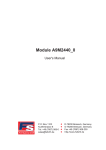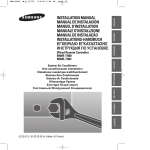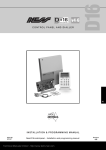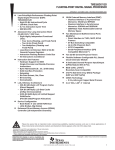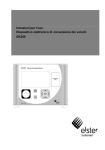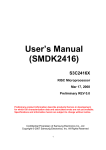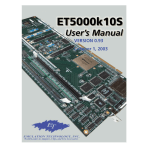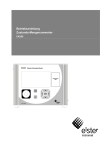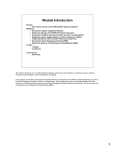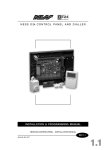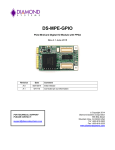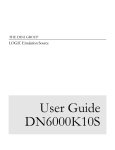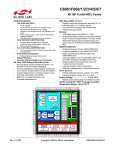Download AN2 ZestETM1 User Interface Examples
Transcript
Application Note 2 ZestETM1 User Interface Examples Author Charles Sweeney and Matt Bowen Version 1.00 Date 16th December 2013 Orange Tree Technologies Version 1.00 Date 16/12/13 Comment First version Disclaimer This document is intended to provide a note for discussion on various issues and whilst every effort has been made by Orange Tree Technologies Limited who retain the ownership thereof to ensure the accuracy of the same, neither these notes or any oral representations made by any member of Orange Tree Technologies Limited, its servants or agents, are intended to be relied upon, nor will Orange Tree Technologies Limited, its employees, members, servants or agents be responsible for any inaccuracies, infringements of intellectual property rights or any matters of a similar nature arising as a result of any publication. The information contained herein is not intended to be or capable of being acted upon or relied upon by third parties and no liability will attach to Orange Tree Technologies by such use Page 2 of 18 CONFIDENTIAL ZestETM1 User Interface Examples 1 References [1] ZestETM1 User Guide, Orange Tree Technologies [2] MCF532x ColdFire Microprocessor Data Sheet, Freescale Semiconductor [3] S3C2416 16/32-Bit RISC Microprocessor User's Manual, Samsung Electronics [4] TMS320C645x DSP External Memory Interface (EMIF) User's Guide, Texas Instruments CONFIDENTIAL Page 3 of 18 Orange Tree Technologies 2 Introduction ZestETM1 is a Gigabit Ethernet interface module and fits between an Ethernet jack and a local device that can then transfer data to or from the network via ZestETM1. The local device can be intelligent like a microprocessor or an FPGA, or it can be a non-intelligent like an ADC. ZestETM1 has a user interface for connecting to the device, and this user interface can be configured in a variety of modes to suit the device. This application note describes these modes and gives examples of how they can be used. Note that these examples are derived from information in the relevant component datasheets and have been characterised by design. The designer should check the relevant datasheet timings for the interface clock frequency that can be achieved. 3 User Interface Modes The ZestETM1 user interface can be configured in one of four modes: • 16-bit SRAM interface • 8-bit SRAM interface • FIFO interface • Direct or "bit-banging" interface Some examples are now given of how to connect devices using each of these modes. Detailed information about each mode is in the ZestETM1 User Guide [1]. The modes are summarised in the last section at the end of the document. Page 4 of 18 CONFIDENTIAL ZestETM1 User Interface Examples 4 16-Bit SRAM Interface The data bus is 16-bits bidirectional. ZestETM1 is the slave on the bus. The master device needs a synchronous bus interface that can be configured to access ZBT (Zero Bus Turnaround) SRAM. The main features of this interface are a single clock cycle chip select followed two clock cycles later by the read or write data. The basic access waveforms are shown in Figure 1. Figure 1. 16-Bit SRAM Interface Some microcontrollers and DSPs have synchronous interfaces but not specifically ZBT SRAM interfaces. However it may still be possible to use these interfaces by adding wait states to position the data correctly, and using a signal such as an address valid strobe for the chip select. The microcontrollers featured here have such interfaces, please see the following sections for how to use them. The example devices described are: • Freescale microcontrollers with FlexBus external interface [2] • Samsung S3C2416 microcontroller [3] • Texas Instruments TMS320C645x DSP [4] CONFIDENTIAL Page 5 of 18 Orange Tree Technologies 4.1 Freescale Microcontroller FlexBus The FlexBus external interface is provided on Freescale microcontrollers such as ColdFire and Kinetis. It can be connected to ZestETM1 as shown in Figure 2 and Table 1. The microcontroller interface should be set up as follows: • One wait state so that write and read data are two clock cycles after Transfer Start. • Auto Transfer Acknowledge as ZestETM1 does not generate this signal. ZestETM1 FlexBus CLK FB_CLK CSn WEn BEn[1:0] A[9:1] DQ[15:0] INTn FB_TSn FB_R/Wn FB_BEn/BWEn[1:0] FB_A[9:1] FB_D[15:0] IRQn EOF[1:0] HEAD LENGTH FB_CS[5:0] FB_OEn FB_TAn Figure 2. Freescale FlexBus Connections to ZestETM1 User Interface in 16-Bit SRAM Mode ZestETM1 FlexBus CLK FB_CLK CSn FB_TSn WEn BEn[1:0] A[9:1] FB_R/Wn FB_BEn/BWEn[1:0] FB_A[9:1] DQ[15:0] FB_D[15:0] INTn IRQn FB_CS[5:0] FB_OEn FB_TAn Comment FB_CLK frequency should be from 5MHz to 125MHz Transfer Start is used as the Chip Select for ZestETM1. If the microcontroller is connected to multiple devices then Transfer Start should be gated with one of the microcontroller Chip Selects. FB_BEn/BWEn [3:2] are not connected Byte addresses so A[0] is tied low and FB_A[23:10, 0] are not connected. FB_D[31:16] are not connected. EOF, HEAD, LENGTH could be connected to D[19:16]. Not connected, but see comment for Transfer Start Not connected Not connected Table 1. Freescale FlexBus Connections to ZestETM1 User Interface in 16-Bit SRAM Mode Page 6 of 18 CONFIDENTIAL ZestETM1 User Interface Examples 4.2 Samsung S3C2416 Microcontroller The Static Memory Controller (SMC) of this microcontroller can be connected to ZestETM1 as shown in Figure 3 and Table 2. The SMC should be configured for: • Synchronous single accesses. • 2 wait states for writes and 1 wait state for reads. This places the data 2 clock cycles after SMAVD, which is used as the CSn for ZestETM1. ZestETM1 Samsung S3C2416 CLK RSMCLK CSn WEn BEn[1:0] A[9:1] DQ[15:0] INTn RSMAVD nRWE nRBE[1:0] RADDR[8:0] RDATA[15:0] EINTn EOF[1:0] HEAD LENGTH nRCS[5:0] nROE nWAIT RSMBWAIT Figure 3. Samsung S3C2416 Connections to ZestETM1 User Interface in 16-Bit SRAM Mode ZestETM1 Samsung S3C2416 CLK RSMCLK CSn RSMAVD WEn BEn[1:0] A[9:1] nRWE nRBE[1:0] RADDR[8:0] DQ[15:0] INTn RDATA[15:0] EINTn nRCS[5:0] nROE nWAIT RSMBWAIT Comment RSMCLK frequency should be from 5MHz to 125MHz Address Valid is used as the Chip Select for ZestETM1. If the microcontroller is connected to multiple devices then Address Valid should be gated with one of the microcontroller Chip Selects. A is byte address and RADDR is word address so A[0] is tied low. RADDR[25:9] are not connected. Not connected, but see comment for Address Valid Not connected Not used, tie high if not used for other devices Not connected Table 2. Samsung S3C2416 Connections to ZestETM1 User Interface in 16-Bit SRAM Mode CONFIDENTIAL Page 7 of 18 Orange Tree Technologies 4.3 TI TMS320C645x DSP The Texas Instruments TMS320C645x DSP has an external memory interface (EMIF) that can be configured for Zero Bus Turnaround (ZBT) SRAM. This is suitable for use with the ZestETM1 16-bit SRAM interface. The connections are shown in Figure 4 and Table 3. ZestETM1 TMS320C645x CLK ECLKOUT CSn WEn BEn[1:0] A[9:1] DQ[15:0] INTn CEn SWEn BEn[1:0] EA[7:0], BA[1] ED[15:0] GPINTn EOF[1:0] HEAD LENGTH SOEn SADSn/SREn BA[0] Figure 4. TI TMS320C645x Connections to ZestETM1 User Interface in 16-Bit SRAM Mode ZestETM1 TMS320C645x CLK ECLKOUT CSn WEn BEn[1:0] A[9:1] CEn SWEn BEn[1:0] EA[7:0], BA[1] DQ[15:0] ED[15:0] INTn GPINTn SOEn SADSn/SREn BA[1:0] Comment ECLKOUT frequency should 5MHz to 125MHz Any of CEn[5:2] can be used be from BEn[7:2] are not connected A is byte address and EA is 32-bit word address so A[0] is tied low and A[1] is connected to BA[1]. EA[19:8] are not connected. ED[63:16] are not connected. EOF, HEAD, LENGTH could be connected to ED[19:16] if a 32bit data bus were used, and then A[9:1]<-EA[8:0]. Not connected Not connected Not connected Table 3. TI TMS320C645x Connections to ZestETM1 User Interface in 16-Bit SRAM Mode Note that although this DSP has a 10/100/1000 interface of its own, using ZestETM1 has the following advantages: Page 8 of 18 CONFIDENTIAL ZestETM1 User Interface Examples • • • • Fast time to market Reduced project risk Offload TCP/IP processing burden from the DSP Very high sustained bandwidth CONFIDENTIAL Page 9 of 18 Orange Tree Technologies 5 8-Bit SRAM Interface This is actually composed of two separate and independent synchronous 8-bit interfaces, one for writing to ZestETM1 and one for reading from ZestETM1. In both cases ZestETM1 is the slave. Write data is coincident with address and control, but read data has a latency of 2 clock cycles. See Figure 5 for the waveforms. Figure 5. 8-Bit SRAM Write and Read Interfaces Page 10 of 18 CONFIDENTIAL ZestETM1 User Interface Examples 5.1 FPGA The 8-bit SRAM interface, with its two unidirectional ports, is suitable for connection to an FPGA. The connections are shown in Figure 6 and Table 4. For FPGA's with Slave SPI configuration (e.g. Lattice ECP3 series), the ZestETM1 SPI port can be connected directly to the FPGA Slave SPI port for configuring the FPGA. ZestETM1 FPGA CLK CLKOUT WEn DA[9:0] D[7:0] REn QA[9:0] Q[7:0] WEn QA[9:0] Q[7:0] REn DA[9:0] D[7:0] INTn EOF HEAD INTn EOF HEAD SPI SLAVE SPI CONFIG Figure 6. FPGA Connections to ZestETM1 User Interface in 8-Bit SRAM Mode ZestETM1 FPGA Comment CLK CLKOUT CLKOUT frequency should be from 5MHz to 125MHz WEn DA[9:0] D[7:0] REn QA[9:0] Q[7:0] INTn EOF HEAD SPI WEn QA[9:0] Q[7:0] REn DA[9:0] D[7:0] INTn EOF HEAD SLAVE SPI CONFIG Write address Write data Read address Read data Optional SPI for configuring FPGA Table 4. FPGA Connections to ZestETM1 User Interface in 8-Bit SRAM Mode For configuring FPGA's without a Slave SPI configuration port, such as Xilinx FPGA's, there are some options: • Use a CPLD as a bridge from the ZestETM1 master SPI port to the FPGA slave serial configuration port. CONFIDENTIAL Page 11 of 18 Orange Tree Technologies • • Use SPI flash for configuring the FPGA, and program this flash from ZestETM1 master SPI. There will need to be a multiplexor between the FPGA SPI chip select and the ZestETM1 SPI chip select. Use the Xilinx MultiBoot master SPI configuration mode. A "golden" or "fallback" configuration file is programmed into the SPI flash either by using JTAG via the FPGA or by pre-programming the flash before board assembly. This configuration file provides a bridge inside the FPGA from the ZestETM1 user interface to the SPI flash for programming the "main" configuration file over Ethernet (e.g. using FIFO high speed mode or master SPI), see Figure 7. The FPGA reconfigures itself from flash with the main file using the IPROG (internal PROGRAM_B) command and registers that specify the start address of the file in flash. If the main configuration also contains the user interface to SPI bridge then the main file in the flash can be updated in the field. This has the added advantage that if the main file update fails then the Multiboot fallback feature means that FPGA will fall back to the golden file and the board can be recovered. User FPGA ZestETM1 User I/F Bridge SPI Flash Figure 7. Using the Xilinx Multiboot Scheme to Program an FPGA Page 12 of 18 CONFIDENTIAL ZestETM1 User Interface Examples 6 FIFO Interface Similarly to the 8-bit SRAM mode, this mode has two separate and independent 8-bit ports, one for data received from Ethernet and one for data to be transmitted to Ethernet. Note that this mode is for data transfer only and the ZestETM1 control registers must be accessed either via the SPI slave interface or the UART interface. If the FIFO interface is connected to a non-intelligent device such as a DAC or ADC then either a simple microcontroller can be used for the control registers, or ZestETM1's Auto Connection facility can be used. With Auto Connection, the control registers do not need to be accessed as ZestETM1 handles all state control for the Ethernet communication channels. Figure 8 shows the FIFO waveforms for TCP transfers. Note that UDP transfers add the datagram length and UDP header to received data, and require datagram length for transmitted data. Hence UDP transfers can be used only when connected to a device that can handle these fields, while TCP transfers can be used with non-intelligent devices such as DAC's and ADC's. Figure 8. FIFO interface read and write operations for TCP frames CONFIDENTIAL Page 13 of 18 Orange Tree Technologies 6.1 DAC and ADC When using DAC's and ADC's the Ethernet network bandwidth must be greater than the DAC or ADC data rate in order to ensure one byte per clock cycle to the DAC and from the ADC. Although ZestETM1 has 1MByte of buffer for each Ethernet transmit channel and about the same for each Ethernet receive channel, it may be necessary to add buffer memory between ZestETM1 and the DAC or ADC to ensure a smooth data rate of one byte per clock cycle. This will depend on the amount of other network traffic interrupting the ZestETM1 network traffic. If the network is point-to-point between host computer and ZestETM1 then the ZestETM1 buffers may be adequate. Figure 9 and Table 5 show a simple scheme without any extra buffering. Clock ZestETM1 CLK Q[7:0] RXn RFn[0] RFn[7:1] RC[2:0] DAC CLK D[7:0] '1' '0' ADC CLK D[7:0] TXn TFn[7:0] TC[2:0] Q[7:0] '0' '0' INTn Figure 9. DAC and ADC Connections to ZestETM1 User Interface in FIFO Mode Page 14 of 18 CONFIDENTIAL ZestETM1 User Interface Examples ZestETM1 DAC/ADC CLK CLK Q[7:0] RXn D[7:0] RFn[7:0] RC[2:0] D[7:0] TXn TFn[7:0] TC[2:0] INTn Q[7:0] Comment ZestETM1 clock output is 125MHz, which is too fast for sustained data rate over gigabit Ethernet, so an external clock source must be used. The clock can be gated with a signal to start and stop the ADC and DAC - the signal can be controlled by e.g. ZestETM1 master SPI port. The clock to the ADC may need to be inverted to meet ZestETM1 timing. Data to DAC Receive strobe optionally connected if the DAC has a write strobe or chip select input Receive Full flags - if using GigEx channel 0, tie RFn[0] high and RFn[7:1] low Receive channel not connected Data from ADC Transmit strobe is not output by ADC's so tie low or drive by flip-flop controlled from e.g. ZestETM1 master SPI port or TFn0 Transmit Full flags not connected or connect TFn[0] (for GigEx channel 0) via inverter to TXn Transmit channel tied low to select GigEx channel 0 Not connected Table 5. DAC and ADC Connections to ZestETM1 User Interface in FIFO Mode Note. It is assumed above that the network data rate is high enough for writing data to the DAC and receiving data from the ADC at one byte per CLK clock cycle. Otherwise, invalid data (or no data if RXn is used) will be written to the DAC, and data from the ADC will be dropped. CONFIDENTIAL Page 15 of 18 Orange Tree Technologies 7 Direct Interface The direct or "bit-banging" interface enables 32 pins of the user interface to be set as either inputs or outputs in groups of 8 pins. These inputs and outputs can then be read or written by a client on the Ethernet network. The states of outputs are held between writes so they can be used to generate waveforms controlling devices. There are strobes and FIFO flags for situations where flow control is required. Only TCP can be used as it doesn't require header information on the user interface, which UDP does require. Note that this mode is for data transfer only and the ZestETM1 control registers must be accessed either via the SPI slave interface or the UART interface. Either a simple microcontroller can be used for the control registers, or ZestETM1's Auto Connection facility can be used. With Auto Connection, the control registers do not need to be accessed as ZestETM1 handles all state control for the Ethernet communication channels. Figure 10 shows the direct interface without any flow control. Figure 10. Direct Interface with No Flow Control This mode can be used to control devices with non-standard interfaces. Some pins could be data and other pins could be strobes and clocks whose state could be changed on every cycle of CLK. For example Figure 11 shows connection to a 7-segment display. It requires simply 8 user interface pins connected to the display's 7 segment pins and 1 decimal point pin. The CLK is not used by the display but since there must be a user interface clock it is the 125MHz internal clock. The display is updated whenever the device on the network writes to the GigEx channel 0, which is the only channel that can be connected to the direct interface. The state of the B outputs is preserved between writes. Page 16 of 18 CONFIDENTIAL ZestETM1 User Interface Examples ZestETM1 CLK B[7:0] B[31:8] Rxn RxEmptyn RxFulln Txn TxFulln INTn Figure 11. Direct Mode Controlling a 7-Segment Display CONFIDENTIAL Page 17 of 18 Orange Tree Technologies 8 Summary of Modes and Devices Table 6 below summarises the recommended mode to use to connect various types of devices to ZestETM1. 16-Bit SRAM Microcontroller Microprocessor DSP FPGA 8-Bit SRAM FIFO Direct Yes Yes Yes Yes Yes Yes ADC/DAC Miscellaneous devices with non-standard interfaces Comments Yes Bidirectional bus so more suited to microcontroller than FPGA Unidirectional buses suited to FPGA Multiple Ethernet channels available for multiple devices Table 6. Summary of Modes and Devices Page 18 of 18 CONFIDENTIAL Only one Ethernet channel so only one device





















